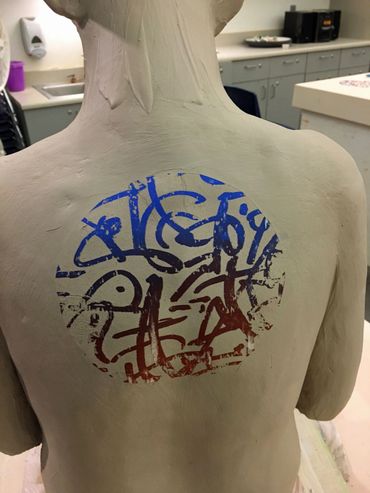MONOTYPE

A monotype is a "one-of-a-kind print. Etching or lithographic ink is applied to a plastic or metal printing plate with a brayer, a brush, or a cloth. Once an image is achieved on the plate a special printmaking paper is placed on the plate and then slowly run through the extreme pressure of the rollers on an etching press. This transfers the image to the paper leaving less than 10% of the ink on the plate, therefore only one print can be obtained.
MONOTYPE 3 COLOR PROCESS




PHOTOPOLYMER INTAGLIO/GRAVURE

Intaglio is to etch (incise or cut) into a surface. A photopolymer intaglio plate is a thin steel plate that is coated with a water-soluble emulsion that is light sensitive. This is a non-toxic etching method that uses water not the traditional acid to etch into a surface. Since this is a light sensitive plate, the marking material used must be light resistant, so a combination of opaque markers, pencils, and/or paint must be used to draw the image. This image is then transferred onto a thin, translucent plastic film such as mylar to make a positive transparency. The photopolymer plate is covered by the positive transparency and is exposed to a very bright metal halide light source. Areas left open and clear of opaque marks will allow light to reach the water-soluble emulsion on the printing plate and harden it. The hardened areas become impervious to water, while the areas left unhardened will wash away during the developing stage and etch the surface. Once the plate is ready, it is inked, wiped, and printed like a traditional etching.
Lessons in Healing-David Manje-15"x11"-Photopolymer Intaglio
SILK AQUATINT (NON-TOXIC)

In traditional copper etching an aquatint is achieved by dusting the surface with a rosin powder. The plate is slowly heated until the rosin particles melt into dots that adhere to the plate surface. Each dot becomes a barrier to the etching acid. When the etching plate is placed into an acid-bath, all areas are "bitten" or corroded that are not protected by the rosin dots.
Non-toxic Silk Aquatint uses a Plexiglass plate on which a silk-like material is adhered. Images are drawn onto the silk with acrylic paint, acrylic varnish, and acrylic molding paste which create blocked areas. These areas resist ink producing a variety of lighter values. All areas of the silk not blocked produce a deep, uniform, velvety black tone. The results from regular and non-toxic methods create almost similar results.
Hermanos en la Tormenta-David Manje-22"x30"-Silk Aquatint
Mono Silkscreen

Night Jack- David Manje-30"x22"-Mono Silkscreen
Chine Colle, Collage and Pochoir
Chine Colle is the process of adhering lightweight paper onto heavier, dampened printmaking paper using a powdered wheat paste. When ready to print, the chine colle paper is sandwiched between the inked surface of a printing plate and the dampened printing paper. As the plate passes through the press the image is printed and the chine colle paper is adhered at the same time. Therefore, this is a process that is done in addition to another printmaking process. David Manje often creates his own chine colle paper by using his own drawings or the bi-product of a previous printing process by cutting images out of damaged prints or using the edges of newsprint that blotted up ink.
Collage is the process of adhering paper onto printmaking paper after it has been run through the press.
Pochoir is the use of stencils in printmaking.

Awaken the Angel 2-David Manje-22"x30"-Photopolymer Intaglio with Chine Colle
Rolling Blends for Background







PRINTING ON CLAY







